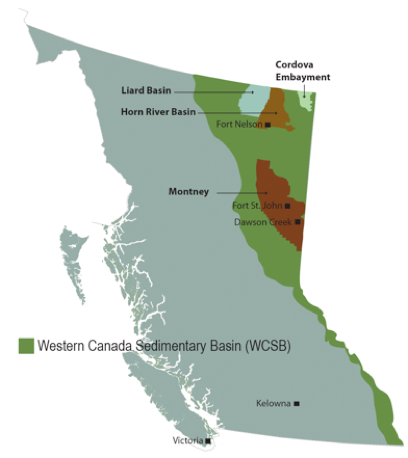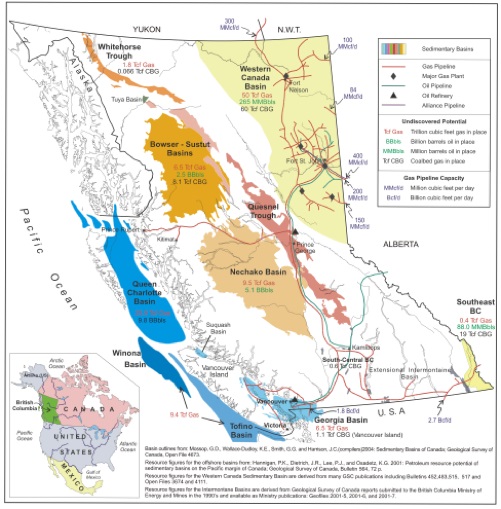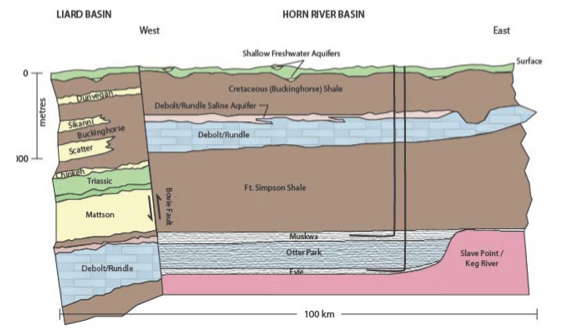
BACKGROUND
• Situation of Natural Gases in BC
• Application and Value of Natural Gases in BC
• Fingerprinting of Natural Gases
Situation of Natural Gases in BC
Natural gas is a mixture of hydrocarbon gases, predominated by methane, typically includes higher hydrocarbons (e.g., ethane through pentane) and frequently non-hydrocarbons, such as carbon dioxide, nitrogen, hydrogen, noble gases and hydrogen sulfide. Natural gas is globally ubiquitous, but particularly important in British Colombia from economic and environmental perspectives.
B.C.’s history of petroleum dates back over 90 years since the 1920’s. The first commercial production of natural gas in 1948 (Pouce Coupe) delivered gas to Dawson Creek (Figure 1). This was followed by the natural gas discovery in 1956 at Clarke Lake in the Fort Nelson region.
Today, the development centers upon B.C.’s reserves of conventional and unconventional natural gas located under the edge of the Western Canada Sedimentary Basin (WCSB) in the province’s northeast (Figure 1). The unconventional gas types present in B.C include: Tight, Shale and Coalbed gas (CBG or coalbed methane, CBM).

Figure 1. Map of B.C. plays in the Western Canada Sedimentary Basin hydrocarbon basins (BC OGC 2013. Area-based Analysis: Overview April 2013).
In B.C., the Montney (Ft. St. John/Dawson Creek), Horn River and Liard Basins and the Cordova Embayment (Ft. Nelson), shown in Figure 2, are among the largest shale-gas deposits in North America, with an estimated resource of approximately 11,000 bcm (billion cubic metre, NEB et al., 2013). These deposits are part of the rich, interprovincial oil and gas reserves of the WCSB connecting B.C. and Alberta.
For example, the 130,000 km2, 100 – 300 m thick Triassic Montney Formation yields oil (179 mcm), natural gas liquids (2,300 mcm NGLs) and natural gas (> 12,000 bcm) (NEB, 2015). Although the deeper, over-pressured plays dominate the unconventional development in B.C. Montney Fm (mid-point depth ~ 1750 m), shallower, underpressured production, similar to Alberta (also Doig Fm), remain of interest. In 2013, the Montney comprised 51 % of gas production in NE B.C. (OGC, 2014).
Natural gas reserve and marketable resource estimates for the Horn River Basin are approximately 314 and 2,000 bcm, respectively, and the production of 4.25 bcm in 2013 accounted for about 13 % of total production in the province. The Jean Marie and Cadomin make up 4.6 and 3 % of NE B.C. gas production, respectively (OGC, 2014).
Note: NGLs are defined as ethane, propane, butane, pentane, and heavier hydrocarbons that are produced in the gas stream out of a well.

Figure 2. Map of northeast B.C. unconventional hydrocarbon plays (BC OGC, 2014. Horn River Basin Unconventional Shale Gas Play Atlas).
Currently in B.C., our known natural gas reserves are approximately 1,200 bcm with an annual production of around 39.5 bcm from over 7,700 producing wells (610 drilled in 2014). (Sources: BC OGC 2013, 2014, CAPP 2011).
B.C. has several other sedimentary basins, which have had more limited exploration, including the Bowser, Whitehorse, Nechako, Fernie, Queen Charlotte, Winona and Tofino Basins (Figure 3). These contain oil and/or both conventional and unconventional gas. The latter includes coalbed gas found in essentially every coalfield throughout the province. The major estimated reserves include the Peace River (northeast), Klappan and Groundhog (north Netchako basin), Elk Valley and Crowsnest (southeast corner), Hat Creek (central interior), and Comox and Nanaimo (Vancouver Island). Exploratory wells in the Peace River and Elk Valley coalfields are assessing the CBG.

Figure 3. Map of B.C.’s active and prospective hydrocarbon basins (BC Ministry of Energy and Mines).
Application and Value
Certainly, the natural gas industry in northeast British Columbia, particularly in the unconventional market, is experiencing a period of sustained growth due to several reasons, including technological (e.g., advanced directional drilling, improved hydraulic fracturing), economic (decline in global oil reserves) and social (lower greenhouse gas emissions and cleaner extraction, transport and use). The rich resources of B.C. natural gas are generating the opportunities for an emerging LNG industry on B.C.’s west coast.
This intensive rise in the exploration and production of natural gas in B.C. brings a range of both opportunities and challenges that can be improved by this BC Natural Gas Atlas. Molecular and isotope signature of natural gases provide important information for exploration activities (e.g., Whiticar, 1994). For example, natural gas signatures can elucidate the kerogen types and maturity of the source rocks that generated the gas (see Appendix 1). Additionally, in unconventional plays, these gas geochemical signatures can help identify spatial variations in productivity, e.g., due to facies changes. When embedded in a Petroleum System Model, the gas data can provide source rock calibration and can identify charge histories. Overall this can substantially reduce exploration risk.
Due to subtle changes in molecular and isotope signatures between and across units (e.g., permeability contrasts) the gas geochemistry assists in the recognition of migration, mixing, segregation and compartmentalization within petroleum systems and the distribution of natural gas liquids. With appropriate sampling density and control gas geochemistry can add insight on the effectiveness of structural and stratigraphic seals and the impact on basin evolution of traps and seal integrity. It can also address questions of secondary alteration, such as water and gas washing and biodegradation.
During production activities, natural gas signatures offer benefits to the operator, which potentially allow them to optimize field operations and gas production. Understanding the compositional variations and quality of the gas within plays can optimize where specific gas-types and production performance can be anticipated.
Wells now utilize state-of-the-art drilling, completion methods and production equipment and techniques. However, there are still concerns that compromised surface casing cements in active well bores, e.g., from pressure cycling during hydraulic fracturing, could be allow the migration of gases to the surface and resulting in fugitive gas releases into the atmosphere. There are also additional concerns of fugitive gases from abandoned well bores. The capability of not only identifying wells that are leaking gas sources, but characterizing the source of the gas has many benefits. In the case of a leaking wellbore, an operator can lower remediation costs by having a high level of certainty as to the gas source, thereby allowing the operator to quickly and efficiently plan remediation of leaking wellbore. This same methodology could be used to remediate old abandoned wellbores – the methodology would allow the service company to pinpoint the horizon(s) leaking, thereby aid intervention strategies to reduce fugitive gas emissions.
Detecting natural gas emissions from natural gas development is critical for responsible development of the resource, and for population health and wellness of communities. Differentiation between microbial and different thermogenic sources of natural gas will be a critical, novel enhancement to the hydrocarbon fugitive emission air-monitoring network. This can work in concert with the BC Ministry of Environment Northeast Air Monitoring Project (Science and Community Environmental Knowledge, SCEK, Fund), a partnership between the B.C. Government, OGC and the oil and gas industry.
This project interfaces and participates in two existing fugitive emission and water quality programs in NE B.C., namely:
1. OGC/UBC ‘Fugitive Gas Emission Characterization Study’
2. OGC/BCMFLNRO/BCMoE/SFU ‘Northeast BC Aquifer Characterization Study’.
In the OGC/UBC study 15 well pads were selected near Fort St. John and Dawson Creek, where most of the unconventional gas development focuses on the upper and lower Triassic Montney Fm (Figure 4). Some wells were drilled to target the overlying Charlie Lake, Halfway and Doig Fm, and the lower Cretaceous Fm. Discussion are ongoing to expand the OGC/UBC study into the Devonian Muskwa, Otter Park and Evie Members of the Horn River Region (Figures 2 and 5).

Figure 4. Stratigraphic cross section Ft. St John region of NEBC (MEM).

Figure 5. Stratigraphic cross section of Horn River and Liard Basins. BC OGC, 2014.
Fingerprinting of Natural Gases
A distinct and diagnostic natural gas compositional signature theoretically can be obtained from a combination of:
1. Molecular abundances – CH4, C2H6, C3H8, iC4H10, nC4H10, CO2, N2, H2S, etc.
2. Stable isotope ratios – δ13CH4, Cδ2H4, δ13C2H6, δ13C3H8, δ13 iC4H10, δ13nC4H10, δ 13CO2, etc.
Recent studies detailed in the Results section show that there is no clearly defined “fingerprint” in NEBC – it is an interpretative result with many gases looking fairly similar to each other. The Geochemistry page shows the complexity in doing Gas Characterization plus the many factors and tools using in that interpretation.
Natural gas signatures in fugitive emissions to aquifers and groundwaters
From an environmental assessment perspective, the BC-NGA will establish a suite of gas fingerprints that can address concerns of natural and anthropogenically-induced seepage or introduction of natural gases into aquifers and surface groundwaters. This aspect of the project is planned to be conducted in conjunction with the two existing joint projects:
1. Northeast BC Aquifer Characterization Study (NBCACS) BC Oil and Gas Commission (OGC), BC Ministries of Forests, Lands and Natural Resource Operations (BC MFLNRO), Environment (BC MoE), and Simon Fraser University (SFU) contacts: C. van Geloven D. Wilford and D. Kirste. During the next years, NE B.C. waters will be routinely sampled from over 100 water and monitor wells and from other exposures to determine their chemical characteristics (inorganic and organic). Our part in this project will be to analyse the dissolved gas molecular and isotope compositions in the waters and provide interpretations on the sources of the gases, i.e., allochthonous vs. autochthonous, or microbial vs. thermogenic, etc. The detailed BC-NGA signature inventory will provide the gas type end-members for attribution of sources.
2. Fugitive Emission Characterization Study BC Oil and Gas Commission (OGC), and University of British Columbia (UBC) contacts: K Parsonage, U. Mayer. Similar to the above NBCACS, this study will interpret the origin of the gases, i.e., allochthonous vs. autochthonous, or microbial vs. thermogenic, etc. In the case of thermogenic gases the project will establish, using the detailed BC-NGA signature inventory, the links of shallow gas occurrences with potential sources in the subsurface. During the project, we are participating in analyzing gas samples collected from over 25 oil and gas well sites in NE. B.C. Our part in this project is to analyse the stable carbon and hydrogen isotope compositions of:
a. Free gases fluxing out of the soil at well sites and
b. Dissolved gases in the waters in the wellbores.
